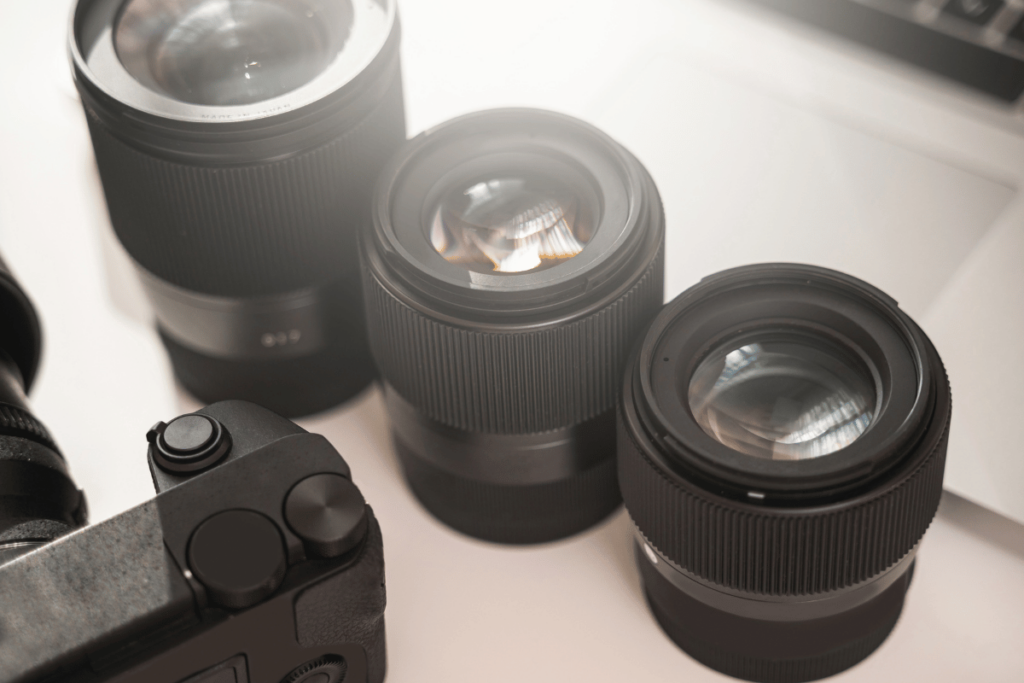
Ever found yourself scratching your head, wondering, “do you need a lens for a mirrorless camera?” Well, you’re not alone. Let’s dive into why a lens is not just a want but a necessity for your mirrorless camera. Here are a few reasons why:
- Image Quality: Without a lens, your sophisticated mirrorless camera is essentially blind. Lenses gather and focus light, bringing your subjects into sharp, colorful life.
- Versatility: Different lenses offer different focal lengths, apertures, and features. They allow you to shoot anything from expansive landscapes to microscopic details.
Types of Lenses for Mirrorless Cameras
Hey there! Let’s dive into the different kinds of lenses you might want to pair up with your mirrorless camera. After all, having the right lens can truly elevate your photography game.
Prime Lenses
First off, prime lenses. These gems have a fixed focal length, meaning you can’t zoom in and out, but what they lack in zoom, they make up for in quality. With fewer moving parts, prime lenses often offer sharper images and perform better in low light conditions.
They’re splendid for portraits and street photography, where precision and detail matter. Plus, they’re usually more compact and lighter, making them a breeze to carry around.
Zoom Lenses
Next up, zoom lenses. These are your go-to if versatility is your top priority. They allow you to cover a range of focal lengths without changing lenses. Whether you’re shooting a landscape or a sports event, a zoom lens lets you quickly adjust your framing.
They’re a bit bulkier and might not match the sharpness of prime lenses, but the convenience is unbeatable.
Wide-Angle Lenses
Got a breathtaking landscape or architecture in front of you? That’s where wide-angle lenses shine. They have a shorter focal length, allowing you to capture more of the scene in a single shot.
These lenses are fantastic for emphasizing depth and perspective. They are a favorite among travel and architecture photographers.
Macro Lenses
Lastly, we’ve got macro lenses. These are all about the tiny details. Macro lenses are designed to focus on subjects close-up. They are perfect for photographing insects, flowers, or intricate textures.
Understanding Lens Mounts
Before we pick out a lens, let’s have a chat about lens mounts. They’re the unsung heroes ensuring your lens and camera can actually work together. Each mirrorless camera brand has its own type of lens mount, kind of like how only certain chargers work with your phone.
For mirrorless cameras, here are the main players:
- Sony E: Known for its wide compatibility with both full-frame and APS-C sensors.
- Canon RF: A newer mount designed for Canon’s full-frame mirrorless cameras.
- Nikon Z: Nikon’s sleek entry into the mirrorless world, compatible with their Z series.
- Fujifilm X: Exclusively for Fujifilm’s X-series APS-C cameras.
- Micro Four Thirds: The cooperative brainchild of Olympus and Panasonic.
Each mount has its unique features. These include sensor size compatibility and flange distance (the gap between the lens mount and sensor). They can also include the number of electronic contacts, which hint at more advanced features.
It’s important to match these specs with your camera to ensure compatibility and achieve the best performance.
Factors to Consider When Choosing a Lens for a Mirrorless Camera
So, you’re diving into the world of mirrorless cameras and wondering, “do you need a lens for a mirrorless camera?” Absolutely! But not just any lens will do. It’s like picking the perfect toppings for your pizza; it really depends on what you’re craving. Let’s break down the factors you need to chew over.
Focal Length and Angle of View
Think of focal length as how “zoomed in” your photos will appear. Lenses with a shorter focal length give you a wider view, perfect for landscapes or group shots, making everything seem vast and grand. A longer focal length brings distant subjects up close and personal.
It is ideal for portraits or spying on wildlife (ethically, of course). Conversely, it is perfect for portraits or ethically spying on wildlife.
Aperture and Speed
Aperture is like the pupil of your camera’s eye, controlling how much light gets in. A larger aperture (indicated by a smaller f-number, like f/1.8) lets in more light, which is fantastic for low-light situations and creating that sought-after blurry background effect. This also impacts the lens’s speed, with a wider aperture allowing faster shutter speeds.
Zoom vs. Prime
Here’s the scoop: zoom lenses offer versatility with variable focal lengths, while prime lenses stick to one focal length but often provide superior quality and larger apertures. It’s the classic jack-of-all-trades versus master-of-one scenario.
Image Stabilization
No one likes blurry photos, right? That’s where image stabilization (IS) steps in to save the day, reducing camera shake especially in dim lighting or when using a long focal length. It’s like having a mini tripod built into your lens.
Autofocus and Manual Focus
Modern lenses usually come with snappy autofocus systems to quickly and accurately capture your subjects. But sometimes, you might want to take control with manual focus, allowing for precision in tricky situations or creative effects.
Size and Weight
Your mirrorless camera is lightweight and compact, so consider how a lens will affect its portability. Larger lenses can offer more features but might weigh you down on a long day of shooting.
How to Use a Lens for a Mirrorless Camera
So, you’ve got yourself a sleek mirrorless camera, huh? Nice choice! But now you’re wondering, “Do you need a lens for a mirrorless camera?” Absolutely, and here’s how to make the most of it.
Attaching and Detaching a Lens
First things first, let’s talk about getting that lens on and off your camera. It’s like a first date—awkward at first, but you’ll get the hang of it. Twist gently until you hear a click, and voila, you’re connected. Removing it? Just press the release button and twist in the opposite direction. Remember, no force needed—it’s a delicate dance, not a wrestling match.
Settings and Modes Mastery
Navigating through your camera’s settings and modes might feel like learning a new language. But it’s your passport to stunning images. Experiment with aperture priority mode to control depth of field. Use shutter priority for motion blur or freeze, and manual mode when you’re feeling adventurous. It’s all about finding the right balance between ISO, aperture, and shutter speed.
Loving Your Lens
Your lens is your best friend—treat it right. A simple lens cleaning kit can keep it spotless. Dust? A soft brush or air blower does the trick. Fingerprints? A microfiber cloth is your hero. Regular care ensures your lens stays in top shape, ready for whatever shot comes next.
Mastering the Art of Photography
Now for the fun part. Different lenses open up worlds of possibilities:
- Portrait Photography: Grab a fast prime lens with a large aperture. Why? Because that shallow depth of field makes your subjects pop with a beautifully blurred background. Hello, magazine-worthy shots!
- Landscape Photography: A wide-angle zoom lens is your go-to. Tiny aperture, big scene—everything sharp, from the flowers up front to the mountains in the back.
- Macro Photography: Ever wanted to capture the tiny worlds within our world? A macro lens with a close focusing distance lets you marvel at the details we usually miss. That narrow depth of field? It makes your tiny subjects the star of their own show.
- Wildlife and Sports Photography: Action-packed scenes need a telephoto zoom lens. Long focal length, fast aperture—you’ll freeze the fastest moments, blurred backgrounds making your subjects stand out like athletes on a sprint.
Conclusion
So there you have it! Navigating the world of lenses for your mirrorless camera doesn’t have to be daunting. Remember, the right lens can significantly enhance your photography, whether you’re capturing the subtle expressions of a portrait or the grandeur of a landscape. Don’t forget the importance of regular maintenance to keep your gear in top shape.
Frequently Asked Questions
What is a mirrorless camera?
A mirrorless camera is a digital camera that lacks a reflex mirror mechanism, enabling a lighter and more compact design. It uses an electronic viewfinder or the rear screen for framing shots.
Why use a lens with a mirrorless camera?
Using a lens with a mirrorless camera enhances image quality and versatility. It allows photographers to capture sharp, detailed images across various photography styles by matching the lens type to the specific needs of the shoot.
What are the different types of lenses available for mirrorless cameras?
There are several types of lenses available for mirrorless cameras, including wide-angle, telephoto, prime, and zoom lenses. Each type serves different photography styles, such as landscape, portrait, sports, and wildlife photography.
What are the benefits of using mirrorless cameras with lenses?
The benefits include compact size, stunning image quality, and the ability to swap lenses for different photography needs. Mirrorless cameras with lenses also offer faster autofocus and a quieter operation compared to their DSLR counterparts.
What are the challenges of using lenses with mirrorless cameras?
Challenges include the overwhelming variety of lens options, making it hard to choose the right one. High-end lenses for mirrorless cameras can also be expensive, posing a barrier for some photographers.
How can I choose the right lens for my mirrorless camera?
Choosing the right lens involves understanding your photography needs, such as the type of photos you want to take and the environment you will be shooting in. Consider the focal length, aperture, and compatibility with your camera. Consulting reviews and resources can also help in making an informed decision.
What resources are available for learning more about mirrorless cameras and lenses?
Resources for learning about mirrorless cameras and lenses include photography blogs, manufacturer websites, online forums, and photography courses. These can provide in-depth reviews, tutorials, and advice from experienced photographers.

